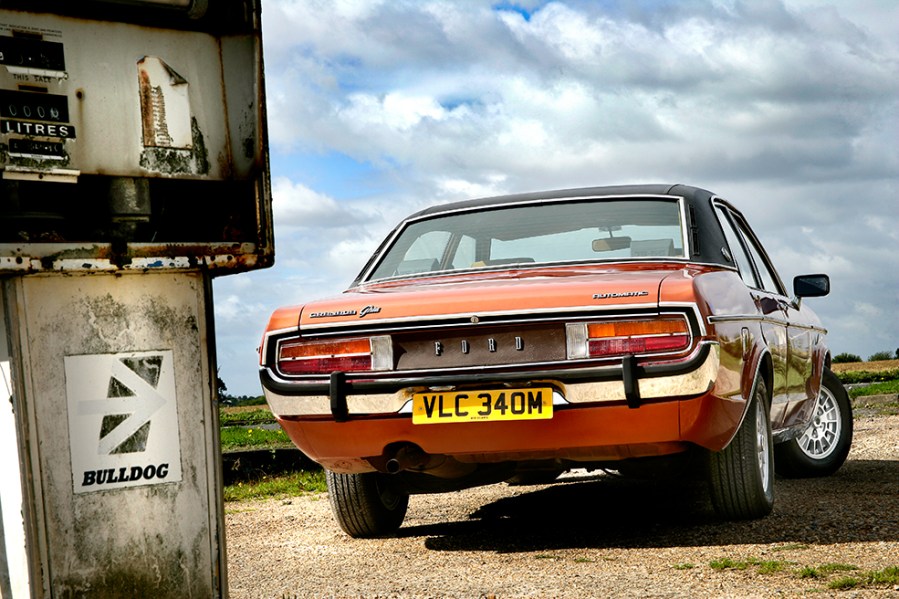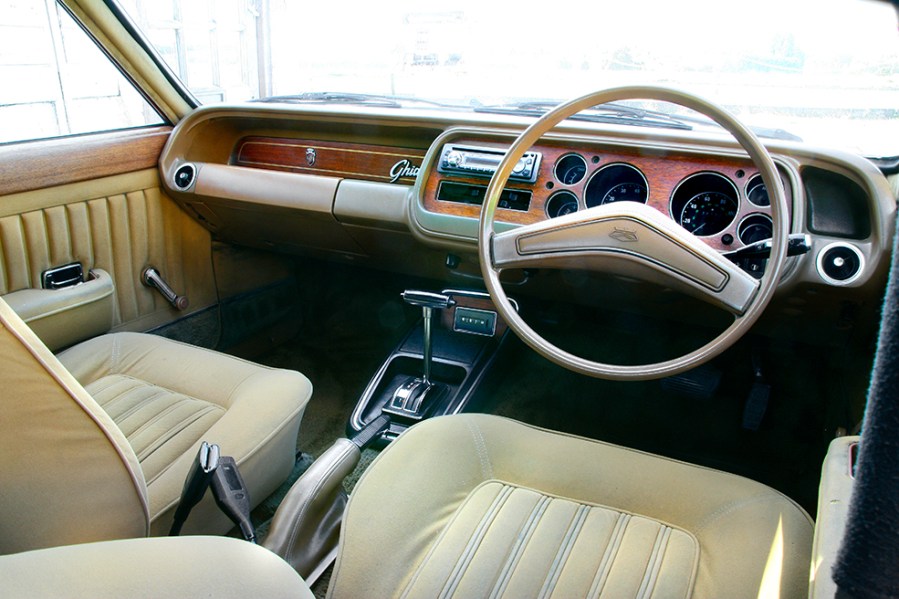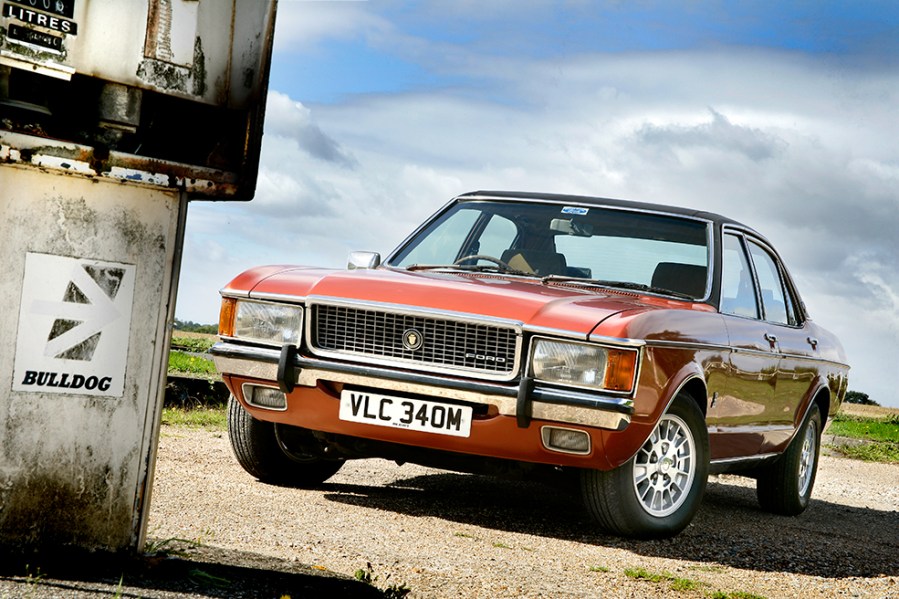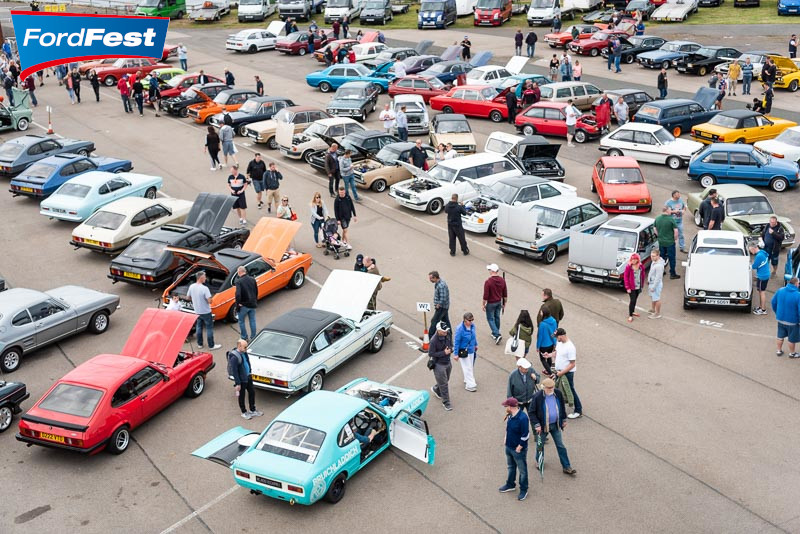Once a mainstay of the executive saloon market, the original Ford Granada offers space, comfort and a great driving experience
Images: Jackie Skelton With thanks to: Graham Boxall, Ford Granada Mk1 & Mk2 Drivers Guild
Ford knew that it had a big job on its hands when it came to replace its popular Zephyr and Zodiac models, and that a big step forward was needed to keep up with rivals Work had begun in the late 1960s and the result was a car that celebrated its 50th birthday in 2022 – the Granada (and Consul) of 1972.
Built at Ford’s Dagenham and Cologne facilities, the big saloon (and estate available later the same year) proved the perfect range-topper for Ford. A Granada on the driveway showed you’d done well for yourself, and if you couldn’t quite stretch to a BMW or Mercedes then this was the next best thing. That was especially true if it wore the Ghia badge: it was the first European Ford to do so and brought lots of extra equipment and luxuries.
Such badge snobbery aside the Granada had plenty to like, from the spacious and comfortable interior to a driving experience that was much improved compared to its predecessors. Ford were on to a winner, and with numerous tweaks and updates the Granada would last until 1977 when the Mk2 was waiting in the wings.

Bodywork
There’s no escaping the fact that rust is the major concern when considering a Mk1 Granada, and with plenty of metalwork to check it’s a case of casting a critical eye over every inch of it. Starting at the front you’ll need to pay close attention to the state of the bonnet and wings (both inner and outer), with a particular focus on the headlamp bowls and the lower sections, and bear in mind that finding original replacements for these panels is tricky. You can source reproduction front wings, either in steel or glass-fibre, from European suppliers but they are quite pricey. The front valance can rot out, too.
Working rearwards the bottoms of the doors are another common rust-spot, and pay plenty of attention to the sills with the back ends being prone to turning frilly. Rear wheel-arches, quarter panels and valance need careful scrutiny as well. And that’s not the end of it as corrosion can strike beneath a vinyl roof while blocked sunroof drains can lead to rot in the C pillars. Satisfied with the condition up top? Then get a good look beneath, focusing on the cabin and boot floors and the front chassis legs. And remember to assess the state of the paintwork and make sure that a shiny exterior isn’t hiding filler and grot beneath.
Finally, you’ll need to consider the condition of exterior trim and chrome; tracking down replacement bits can prove difficult (light units are scarce) so anything that is damaged or missing has the potential to make restoration more of a headache. That said, the likes of Motomobil in Germany is a good starting point for sourcing spares. If all this sounds like bad news it’s no worse than many other classics of this period, and while a major restoration project needs to be approached with a degree of caution there’s plenty of knowledge and advice to be found within the various Granada owner’s clubs.

Engine and transmission
While you’ll find cars for sale powered by the smaller engines it’s the lusty 3.0-litre V6 that tends to be most common, and it’s a unit that suits the Granada’s relaxing driving experience. It’s also an engine that, with proper care, will prove capable of covering big mileages so evidence that the oil and filter have been changed every 3000 miles will be reassuring. Don’t ignore the usual checks for exhaust smoke, overheating, low oil pressure and signs of head gasket failure but assuming it’s not been neglected there’s not much to worry about, and parts supply is very good.
Those same checks apply to any of the engines you might come across, and while camshaft wear can affect the 2.0-litre Pinto it’s a very easy engine to work on or rebuild on a DIY basis. The mechanical simplicity continues with the transmissions where you’ll find either a 4-speed manual or the C3 3-speed automatic. The former is usefully robust and a test drive will soon reveal any whines or noises that point to the need for a re-build. Don’t to forget to check the operation of the clutch, although replacement isn’t difficult and you can source a replacement for less than £100.
As for the automatic, it’s both strong and reliable so really just needs a check of the fluid to make sure it’s not sludgy or blackened. Shifts should be free of jerks or delay, but should an overhaul be needed there are plenty of specialists that can handle this. Finally, use the test drive to check for any noises from the back axle or clunks caused by worn prop-shaft joints although neither are a major cause of concern or expense should an overhaul or repairs be needed.

Suspension, steering and brakes
Ford equipped its big saloon with double wishbone suspension up front and an independent set-up at the back, and it resulted in ride and handling that received plenty of praise from motoring magazine road testers of the day. Well-maintained examples should still impress in both of these departments today, and if you’re looking for a classic that’ll cover big miles in comfort you’ll probably find the Granada very much to your liking.
There’s not much to worry about in terms of problems, either, so you can just concentrate on checking for the usual suspects of worn dampers, broken springs and corrosion around mounting points. Sourcing original-specification bushes isn’t always straightforward but the easy answer is to replace them with polyurethane items; doing the whole lot can see costs add-up, especially once labour is factored-in, but it’ll be worth it in the long-run. Another aspect that made these Granada’s good to drive was the precise and accurate rack and pinion steering, so any waywardness or slop will need further investigation. Aside from the rack itself where a rebuild will be needed, parts are available so an overhaul shouldn’t be problematic. Check for any leaks from the power-assistance hydraulics, though.
As for the brakes, they were well up to the task but it’s worth checking for the usual signs of wear and neglect. Consumables such as pads and shoes are easy enough to find but sourcing a replacement master cylinder or servo isn’t quite so straightforward, so you’re looking at a specialist rebuild. Calipers can be re-built, too, and it’s neither a difficult nor expensive job. Lastly, some cars are fitted with alloy wheels so check for corrosion and damage and ensure that examples stored away for shows and very occasional use aren’t sitting on aged tyres.

Interior and trim
These cars certainly aren’t lacking when it comes to space and comfort, and those attributes alone are enough to make the Granada a very attractive ownership proposition. Where difficulties crop-up is sourcing replacement trim, so don’t be surprised to find the example you’re considering isn’t original in this respect. In any case, you’ll certainly need to spend time assessing the condition of seats, carpets and plastic mouldings; while finding a rust-free car is far more important don’t underestimate the expense of professional refurbishment, or the hassle involved in tracking down missing bits.
That’s pretty much the extent of the bad news, though. Equipment levels are simple by modern standards so it’s just a matter of checking that the likes of switchgear, windows, locks and sunroof mechanisms all work as they should, and the straightforward electrics don’t present much of a problem, either.
Scruffy wiring and corroded connections are likely to be at the root of most problems, although it is worth reassuring yourself that the car you’re considering hasn’t been subjected to amateur repairs and modifications. There’s the potential for all manner of bodges over the years, and plenty of time can be spent sorting them out.

Ford Granada Mk1: our verdict
If you’re looking for a family-friendly classic that’s good to drive then you’ll likely find the Granada a very appealing prospect. The Ford badge might not have the cachet of the premium German marques, but when it comes to all-round ability such things really don’t matter. The comfort, space and refinement on offer make long journeys a pleasure, and if you opt for the smooth 3.0 V6 you won’t feel short-changed by the performance, either. Combined with the automatic gearbox it’s a very relaxing way to travel.
If there’s a downside to ownership it’s the potential for corrosion and the rarity of some parts, and while it’s no different to many rivals in that respect it does mean you’ll want to be circumspect before considering a restoration project. You’ll be better off finding an example where all the hard work has already been done, in which case you can just concentrate on keeping it in tip-top condition. And that shouldn’t be too difficult given the helpful and knowledgeable owner’s clubs that are out there. Yes, the Mk 2 was much-improved but the original Granada very much deserves consideration.
While these cars aren’t exactly common in the classifieds you will find a small number for sale at any one time, and the clubs are a good starting point if you’re keen on bagging this big Ford. We’re looking at prices for the 3.0-litre V6 saloon here, and even a complete basket-case could command £2000-3000 with a less dilapidated restoration a thousand or two more. For something rather nicer you’ll need to budget in the region of £7000-9000 while anything considered to be in the excellent category is comfortably heading for the mid-teens. The absolute best can fetch anything from £20,000 upwards.
That values have been rising in recent years reflects the enthusiasm out there for classic Fords, and as the numbers of restoration cases dwindle with only good ones being left you can expect them to continue climbing. As for the remainder of the range, smaller-engined models can be a little cheaper than the figures quoted here, estates are similar to saloons, and coupes are worth a little more.

Ford Granada Mk1 timeline
1972
The Granada is launched alongside the cheaper Consul variant with buyers offered a range of trims and V4 or V6 engines. The practical and spacious estate model arrives in September
1973-1974
There are plenty of changes, including the disappearance of the 2.5 V6 engine and power-assisted steering becoming standard. 1974 sees the arrival of the plush Ghia version, while the same years marks the UK debut of the stylish Coupe
1975
More changes include a 2.0 OHC engine to replace the V4 and revisions to the suspension, along with improvements to trim and equipment. The latter is tweaked again in October which also sees the Consul badge retired
1977
Production comes to an end in readiness for the Mk 2. Around 850,000 Mk 1s had been made
Ford Fest 2024
If you love classic Fords of all ages, shapes and sizes, Ford Fest 2024 should be on your calendar.
Held at Mallory Park Circuit in Leicestershire on Sunday, September 22, Ford Fest 2024 is set to bring together all the best Ford cars in the country, with club displays, show-and-shine and live action all on the billing. Themed displays will bring together some of the best examples of the breed, while an extensive autojumble and retail areas will keep bargain hunters happy.
There’s also the option to camp on-site – and you can even take your own car on track with the option of professional instruction.
For full ticket pricing details simply click the button below!




































